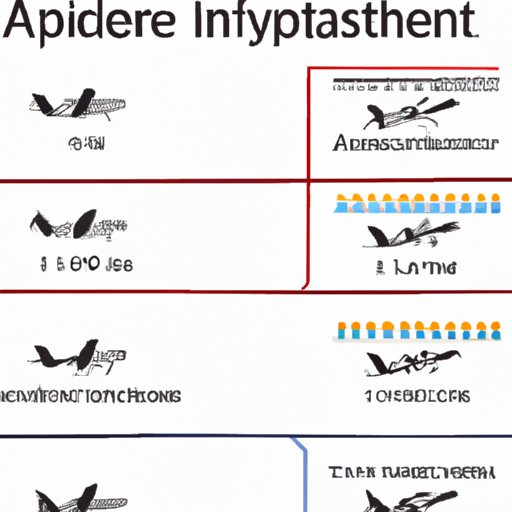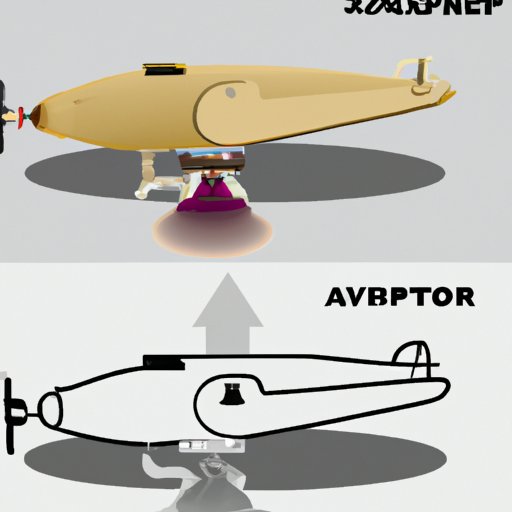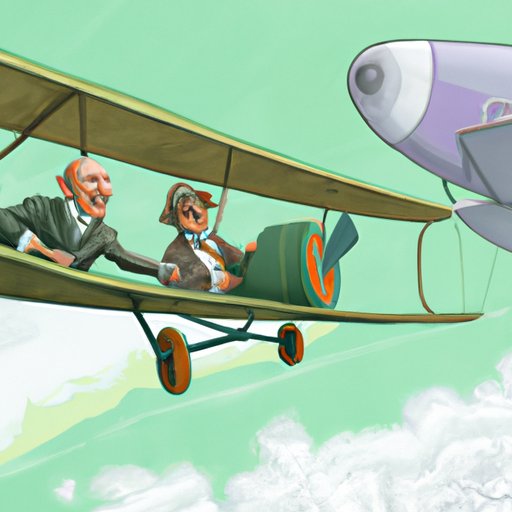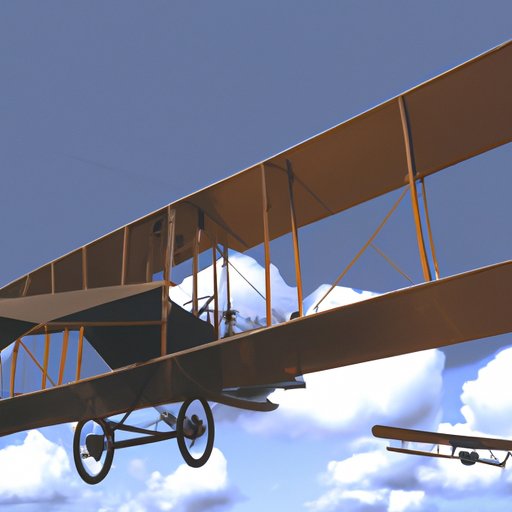Introduction
An airplane is a powered, heavier-than-air aircraft that is propelled forward by thrust from an engine. It is designed to take off and land on a runway, typically with one or more sets of wings that generate lift as the plane moves through the air. Airplanes have become an integral part of modern life, providing a means of transportation for passengers and cargo around the world. But when were airplanes first invented, and who were the pioneers who made it possible?
History of the Invention of Airplanes
The history of human flight spans centuries, with early attempts at taking to the skies dating back to the 11th Century. One of the most famous attempts was made by the English monk Eilmer of Malmesbury, who in 1010 AD constructed wings from linen and wood and jumped from the top of a tower. Although his attempt ended with a crash landing, it marked the beginning of a long journey towards successful human flight.
Until the 19th Century, all attempts at flight relied on gliding or hot-air balloons, but in 1804 Sir George Cayley developed the first fixed-wing glider. He also recognized the need for an engine, and proposed the use of steam power as the most likely form of propulsion. This sparked a flurry of innovation, and inventors around the world began experimenting with various designs. The most successful of these was Otto Lilienthal, who achieved the first successful powered flights in a glider in 1895.
Following Lilienthal’s success, two brothers from Ohio named Wilbur and Orville Wright set out to build a successful powered aircraft. Through a series of experiments, they developed a method for controlling an aircraft in flight, and in 1903 their ‘Flyer’ became the first manned, powered, and controlled heavier-than-air craft. On December 17th, 1903, Wilbur and Orville Wright achieved the first successful powered flight, traveling 120 feet in 12 seconds.

Timeline of Development of Airplanes
Since the Wright Brothers’ first powered flight in 1903, the development of airplanes has been rapid and far-reaching. Here is a brief timeline of some of the major milestones in the history of airplane invention:
19th Century – Early Attempts and Successes
- 1804 – Sir George Cayley develops the first fixed-wing glider
- 1883 – John J. Montgomery makes the first controlled, sustained flight in a glider
- 1890 – Clément Ader achieves the first powered takeoff in a steam-powered aircraft
- 1895 – Otto Lilienthal achieves the first successful powered flights
20th Century – Wright Brothers and Beyond
- 1903 – Wilbur and Orville Wright achieve the first successful powered flight
- 1909 – Louis Blériot becomes the first person to fly across the English Channel
- 1917 – Igor Sikorsky builds the first four-engine aircraft
- 1927 – Charles Lindbergh completes the first nonstop transatlantic flight
- 1935 – Howard Hughes breaks the record for fastest around-the-world flight
21st Century – Modern Advances
- 2003 – Burt Rutan and Paul Allen launch SpaceShipOne, becoming the first private organization to send a human into space
- 2009 – Airbus launches the world’s largest passenger airliner, the A380
- 2014 – Solar Impulse 2 becomes the first aircraft to fly around the world using only solar power
- 2018 – Boeing tests the world’s longest range commercial jetliner, the 777X
Exploring the Impact of Airplanes on Modern Society
The invention of airplanes has had a profound impact on our world. From its humble beginnings as a means of transport for wealthy individuals and military personnel, it has evolved into a global industry that forms the backbone of much of the world’s economy. Here are just a few of the ways in which airplanes have changed modern society:
Mobility and Globalization
Airplanes have enabled people to travel faster and farther than ever before, making it easier to explore the world and experience different cultures. According to the International Air Transport Association (IATA), air travel carried 4.5 billion passengers in 2019 alone. This mobility has opened up new opportunities and helped to bring people closer together, leading to increased globalization and greater understanding between nations.
Military and Commercial Applications
Airplanes have long been used for military applications, such as reconnaissance and bombing missions. But they have also revolutionized the world of commerce, enabling companies to transport goods quickly and efficiently across large distances. The rise of international trade has led to economic growth and prosperity around the world, creating jobs and improving standards of living.
Environmental Impacts
While airplanes have had a positive impact on many aspects of modern life, they are not without their drawbacks. Air travel is responsible for a significant amount of pollution, including greenhouse gases that contribute to climate change. In response, the aviation industry has invested heavily in research and development to reduce the environmental impacts of air travel, such as the use of biofuels and electric-powered aircraft.

How Airplane Technology Has Changed Over Time
Since the invention of the airplane, engineers and scientists have continued to push the boundaries of what is possible. Here are some of the ways in which airplane technology has changed over time:
Engines and Materials
Early airplanes were powered by gasoline engines, but advances in technology have led to the development of more efficient and powerful engines, such as jet and turboprop engines. Similarly, materials used in aircraft construction have changed significantly over time. Aluminum alloys and composite materials are now commonly used to make airplanes lighter and stronger.
Design and Aerodynamics
Aerodynamic design has come a long way since the days of the Wright Brothers. Computer-aided design (CAD) and computational fluid dynamics (CFD) have enabled engineers to create more efficient and aerodynamic shapes, reducing drag and improving performance. This has allowed airplanes to fly faster and farther than ever before.
Automation and Avionics
Modern airplanes are fitted with sophisticated avionics systems that enable pilots to navigate and control the aircraft with greater accuracy and safety. Autopilot systems have also been developed, allowing pilots to program the aircraft to fly itself for certain stages of the journey. This has improved the efficiency of air travel and reduced the risk of human error.

Pioneers Who Led the Way in Airplane Invention
Throughout the history of airplane invention, there have been a number of pioneering individuals who have pushed the boundaries of what is possible. Here are some of the key figures who have made a significant contribution to the development of airplanes:
Otto Lilienthal
German engineer and aviator Otto Lilienthal is widely credited as the father of modern aviation. His experiments with gliders in the late 19th Century led to the first successful powered flights, paving the way for the Wright Brothers’ historic first powered airplane flight in 1903.
Wilbur and Orville Wright
American brothers Wilbur and Orville Wright are perhaps the most famous names in the history of aviation. After years of experimentation, they developed a method for controlling an aircraft in flight, and in 1903 they achieved the first successful powered flight. Their achievements earned them the title of “The Fathers of Aviation”.
Igor Sikorsky
Russian-born engineer Igor Sikorsky is credited with building the world’s first four-engine aircraft, the S-22, in 1917. He later went on to develop helicopters and other vertical-takeoff-and-landing (VTOL) aircraft, and is remembered as one of the greatest innovators of the 20th Century.
Howard Hughes
American aviator and entrepreneur Howard Hughes is best known for his record-breaking around-the-world flight in 1935. He also pioneered the development of commercial airliners, and played a key role in the evolution of military aircraft during World War II.
Conclusion
The invention of airplanes has revolutionized the way we live, work, and travel. From its earliest beginnings in the 19th Century to its current status as a multi-billion dollar industry, airplane technology has come a long way in a relatively short period of time. We owe a great debt of gratitude to the pioneering individuals who made it possible, such as Otto Lilienthal, Wilbur and Orville Wright, Igor Sikorsky, and Howard Hughes.
As we continue to explore the possibilities of flight, it is important to remember the importance of sustainability and safety. By continuing to innovate, we can ensure that air travel remains a safe and efficient means of transportation for generations to come.
(Note: Is this article not meeting your expectations? Do you have knowledge or insights to share? Unlock new opportunities and expand your reach by joining our authors team. Click Registration to join us and share your expertise with our readers.)
